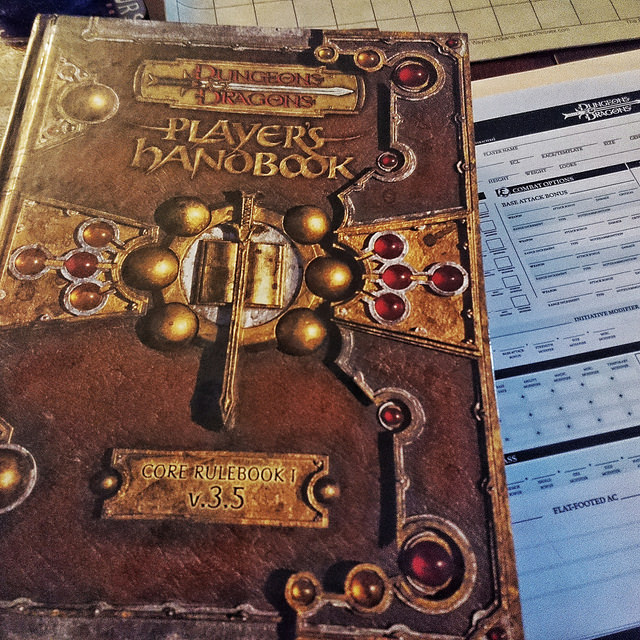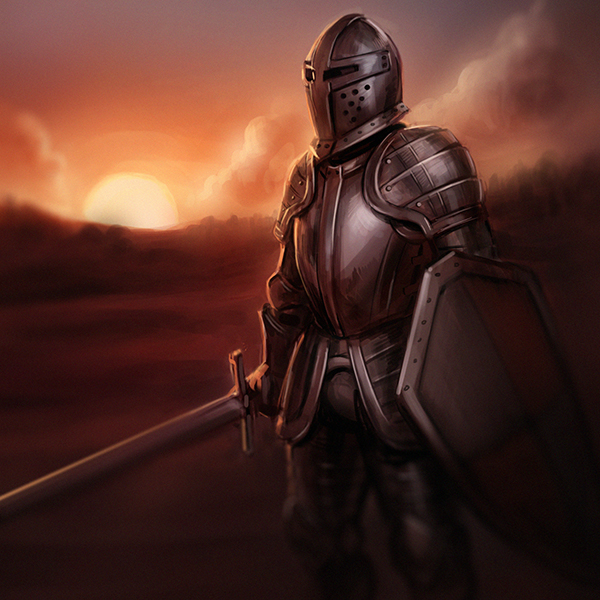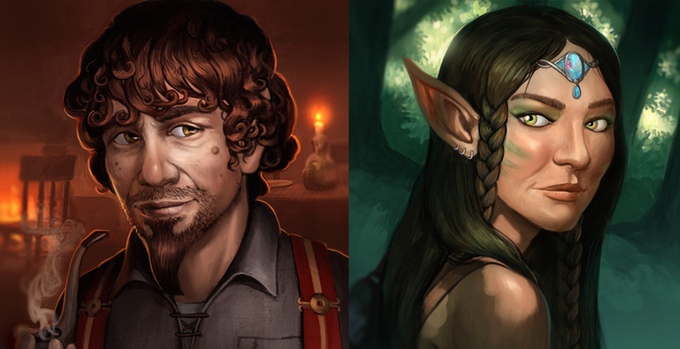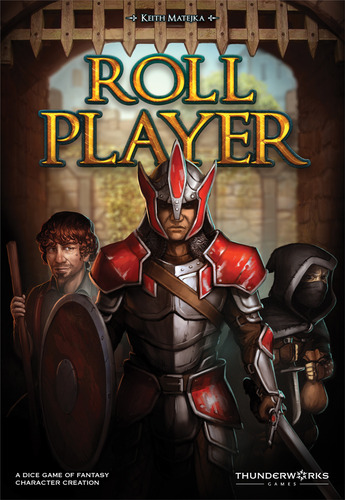As part of our October Spotlight on Roll Player, we strive to inform readers of little extra tidbits surrounding the game. Games are made by people, and one of those tidbits we enjoy is learning a little bit more about the people behind them. Some designers shy away from the public stage, while others enjoy being front and center.
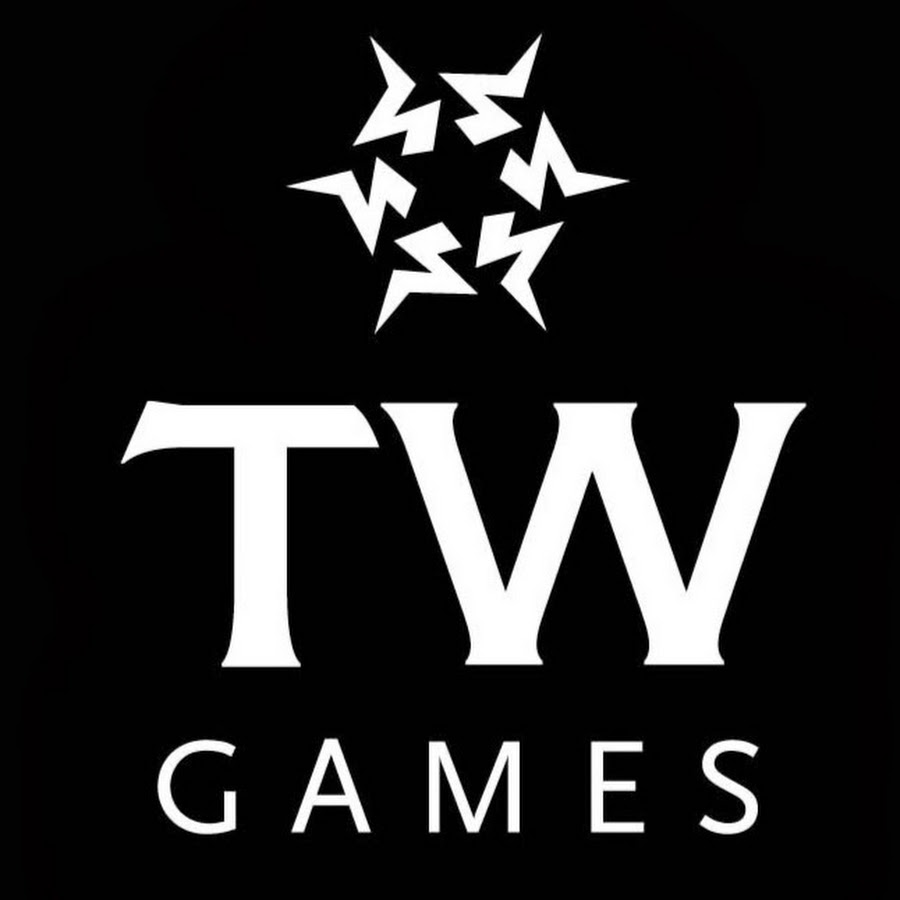 In the case of Keith Matejka, he’s never more happy than when people find his somewhat quixotic game themes as enjoyable as he does. Following up to his inaugural game of Bullfrogs, where armored frogs fight over control of the pond’s lily pads, Keith found a way of turning the metagame experience of creating RPG characters into a game itself.
In the case of Keith Matejka, he’s never more happy than when people find his somewhat quixotic game themes as enjoyable as he does. Following up to his inaugural game of Bullfrogs, where armored frogs fight over control of the pond’s lily pads, Keith found a way of turning the metagame experience of creating RPG characters into a game itself.
We’re not sure how either, but somehow, he found a way. And the gaming world is all the better for it.
Donning the dual hats of both designer and publisher, Keith never shies away from investing energy into his projects and trying to share them with as many people as he can. With Roll Player, you get all the fun of RPG creation while saving you the heavy burden of committing to a two year campaign. Which is for the best really, since you just know your buddy Derek would just bail a month into it anyway.
In the dice placement and dice manipulation game Roll Player, each person is trying to create, aka ‘roll’, a typical fantasy-laden tabletop character. The entire premise focuses on rolling a pool of dice each round and then claiming them in a strategic manner to boost or alter your character’s stats. The higher you can boost your numbers, the more points you generate for the end of the game. Between stat bonuses, alignment choices, and a bevy of skills and armor to claim throughout the game, your goal is to see who can make the most capable adventurer before you even leave the tavern.
Frankly, we’re a bit surprised no one else has tried this approach before. We wanted to know how Keith came up with this design concept and why he felt like he wanted to go all Inception on the idea of character creation. So we sat down with him to find out. Hopefully you’ll find it enlightening, and maybe, just maybe, we can all use that for some kind of lore bonus or something. Enjoy!
Round One Questions
CR: What was your Gateway Game?
The games that got me into gaming as a young boy were Scotland Yard, Survive, Crossbows and Catapults, and Dungeons & Dragons. Once I discovered video games, I moved away from tabletop stuff. In the world of video games, I loved anything with amazingly detailed worlds. Many of them had roots in tabletop gaming, like Ultima IV, Fallout, Shadowrun, and EverQuest. When I was in college, I started getting more and more into RPGs. We played a lot of World of Darkness stuff like Vampire, Werewolf, Changling, etc., as well as D&D, GURPS and more Shadowrun. After college, that died down too.
About seven years ago, I sat down to play a game with a friend that was part of this new resurgence in tabletop games: Puerto Rico. None of us had played, so we trudged through the rules and played it 3-4 times that weekend. We really enjoyed it. My eyes had opened up to the hobby again, but I wasn’t 100% hooked yet. I had also started playing D&D again with my friends from college, but I found I didn’t have the time to commit to the game like I used to. Then, I read about Descent and Arkham Horror. These were RPG-like experiences that I could have in the fraction of the time. Huzzah! So, I dove in head first. I started buying games and seeking out gaming groups in my area. The rest is history.
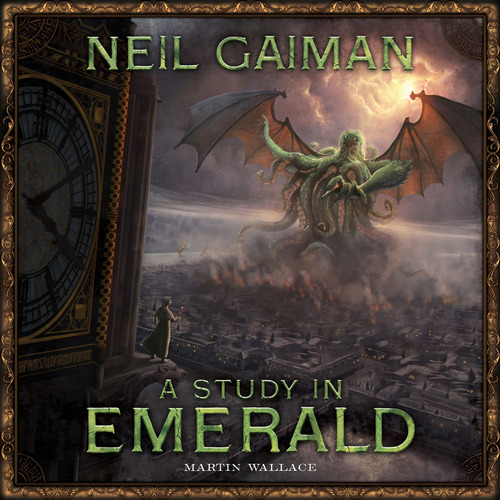 CR: What was the last game you really enjoyed playing (besides Roll Player)?
CR: What was the last game you really enjoyed playing (besides Roll Player)?
I got to play one of my all-time favorite games last week – A Study in Emerald. The more I play it, the more I enjoyed it. It’s such an interesting smashup of mechanics from my favorite designer of all time, Martin Wallace. I was an early backer of the original Kickstarter version; I even built the Print and Play version he had up on the page. Now with the new edition, I’m loving it even more. Highly recommended.
CR: How big is your game collection?
Not huge. Maybe 300 titles? I tend to get rid of stuff that I think is just okay. I also hold off on buying a lot of new stuff as many of the other gamers in my regular group tend to buy the newer stuff. I get to play it, but often I don’t end up getting a copy for myself. I like to collect lesser-known games and bring those to game night. I let the other gamers bring out the newer titles while I bring older ones many of them have never heard of.
CR: What is your favorite type of game to play?
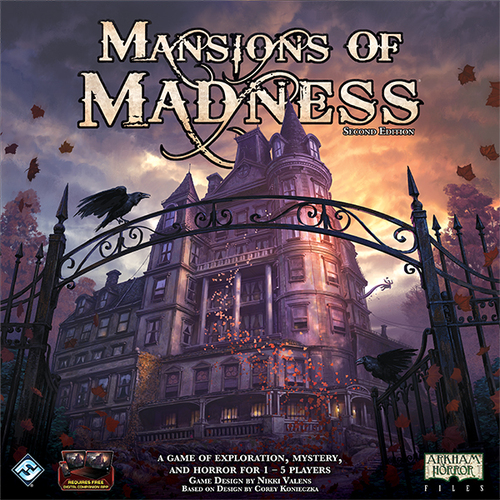
All haunted house games are thematic. Deadly, but thematic.
My tastes are pretty eclectic. I love innovative mechanics, but I also like games with mechanics that really tie the theme in seamlessly. If there’s a story to tell after the game is over, I really like that. Some of my favorites include War of the Ring, Mansions of Madness, Automobile, A Few Acres of Snow, and Last Night on Earth.
CR: How do you feel about Monopoly?
It’s a game that a lot of people hold close to their heart as being “the” board game experience. I think it’s alright, though I haven’t played it in many years. When I hear people talking about it, I just want to encourage them to explore all the other amazing games that have been designed since then.
On Roll Player
CR: It seems safe to say that you’ve had some experiences with tabletop RPGs. Which RPGs have captured your attention most over the years?
Most of my RPG experiences were when I was younger. I really enjoyed pouring over the red box, blue box, and green box stuff for D&D back then. I used to make my own dungeon maps and designed encounters, though I never really got to play much. I escaped in D&D novels like the Hickman and Weiss Dragonlance stuff. I still read some fantasy novels, but it’s harder to find time to dig into them now that I’m a board game designer / publisher and a dad. Shadowrun has always been one of my favorites though. I love the melding of fantasy and sci-fi in that world. When I was younger, I also really enjoyed the TMNT roleplaying game. Playing as a mutant animal just seemed cool to me.
CR: Obviously there’s a story behind the idea of Roll Player because of those past experiences. How did you decide to turn character creation itself into a game?
I was at a game prototype convention here in Madison a few years ago called Protospiel. There was some design challenge going on where designers were asked to design a 16-card RPG. I wasn’t really interested in submitting a design for it, but a friend of mine, James Ryan, wanted to show me what he had been working on. As part of his design, he dealt out two cards to each player. One had a positive trait on each side. The other had a character flaw, I believe. Before starting the game, you were asked to pick a side from each card. It was the fastest character creation I had ever experienced, but it was surprisingly fun.
We played through his game for a little, but this light bulb went off in my head that I couldn’t ignore. When I was deciding my character configuration I just wanted to keep doing that. I had just been playing Skyrim the previous week, so I was very much in a fantasy mindset. I said to myself, “Why hasn’t anyone done a game just about creating characters? So many people think that’s the best part of playing RPGS?” So, I decided I was going to do it.
The next day I was buying handfuls of dice at my local game stores and I had a rough prototype of my own to start playtesting within a couple days. I pulled out all my old D&D books and characters as a starting point. What was important when creating a character? Rolling dice and adding them up for your stats, of course. That’s where is started. The core game didn’t change much from that first prototype, though many of the details did. I was playtesting three times a day, making changes between each one for almost 2 months straight. Eventually it slowed down, but that first couple months was a flurry of development. I felt like I caught lightning in a bottle, and I had to dedicate all my efforts on getting this game out. Because if I didn’t, someone else was going to.
CR: Did you manage to squeeze any Easter Eggs of your RPG history into the game anywhere?
Not really. My most memorable roleplaying experiences were actually playing Vampire, which don’t really fit this theme that well. Roll Player is intentionally ‘generic’ in many ways, to allow players to reminisce upon their own past games when playing.
CR: The game uses d6 dice. Was there any point in the game’s development where other dice were considered?
To me, fantasy roleplaying = d6’s. So using them was the focus from the beginning. Also, d6’s are the most affordable to put in a board game in terms of production costs. I knew there was going to be 73 dice in the box to accommodate four players. I needed to find ways to keep the costs under control, so anything else just wasn’t in the cards. I have thought of trying to find a way to get the d20 in the game somehow, as it is also very prevalent in fantasy roleplaying, but I didn’t find a good fit for one.
CR: The game seems to strike a balance between casual gaming and strategic dice placement. Was that always the intended goal for Roll Player?
Roll Player actually started out as a much lighter game. Elements like the backstory card and the alignment grid were later additions. The original version was more random as well. There are still some playtesters from those early versions that still wish it was lighter, but the final version ended up being a little more strategic and thinky. One of the reasons the complexity was driven a little harder was the economics of the game. I couldn’t see the game existing without 18 dice on each player’s character sheet and you always need an extra die to roll when rolling up a character. Which means I needed 73 dice for four players. That means the cost of the game is going to be relatively high, especially compared to Bullfrogs. Lighter games usually come in at a price-point under $30, and the components of this game were going to require an MSRP of double that.
I started looking at ways to add more complexity. These additions allowed me to include even more elements of the classic character creation process. Playtesters were looking for more reasons why the dice color should matter. So, the backstory card came into being. Playtesters wanted to be able to activate cards. So, alignment became a new element. Alignment actually started as a scale that just went up and down. Over time, it was clear that RPG fans wanted a full grid of 9 alignment positions. So I created a version that adopted that, and people really enjoyed it.
CR: Roll Player’s theme focuses on the classic fantasy style RPGs. Could you foresee expanding the game out to evoke other RPG classics, like urban fantasy or cyberpunk?
I would love to do additional themes down the road, but right now I’m focused on taking the fantasy version further. I am personally very interested in those other genres of RPGs, but I’m less interested in just re-skinning this to some other theme. I want to do other cool new stuff with the base I’ve established.
CR: Roll Player was your second Kickstarter, after Bullfrogs. What was one of the unintended lessons you brought with you from the first campaign to this one?
Running a Kickstarter is tough. There’s a lot of stress because you’ve invested a lot of yourself into the product, and then it’s time to see if people love it as much as you do. There are also a lot of other great games on Kickstarter at the same time, and you’re all fighting for attention.
The main thing I brought with me was just not to get so stressed out. Much of that comes from just being more prepared. It’s easy to deviate from your plan because of a backer comment or message. During the Bullfrogs campaign my original plan was flawed, and I was scrambling to right the ship all the way through. Roll Player was pretty much all figured out by the time the campaign launched. That made the Kickstarter process much more pleasant, and rewarding.
CR: Finally, we have to ask: If YOU were a character, what would your alignment be? Be honest.
Easy – Chaotic Good. I feel strongly that people should be able to do what makes them happy and that people are generally good.
Many tabletop RPGs can take weeks to plan, months to play, and years to finish. In many cases, the whole process of making a simple character for that world can be a challenge – hence Roll Player’s reason for existing in the first place.
It’s not that extensive RPG campaigns are bad, but when even designing your identity can be an ordeal, it’s understandable why some gamers turn to shorter alternatives. Roleplaying is a perfectly valid pastime, regardless of whether your endgame is to portray a suave vampire, a futuristic biohacker, or Mr. Middle-Earth. And if you have the means to do so, then go for it.
For those of us who don’t have the means to commit, we thankfully now have a viable alternative that indeed focuses on the best part – the character creation. Roll Player is ideal when time is not on your side but you still miss the experience of dropping a boatload of dice on the table to create a brand new identity.
What’s more, Roll Player doesn’t cripple your effectiveness if you’re one of those people who are impressively bad dice rollers.
Yeah, we have one of them too. The poor souls…
We’re excited for this alternative to character creation, and to celebrate, we’re offering up a copy of Roll Player! But we need to make sure it’s going to the right person. So step forth adventurer and see if you are indeed worthy.
Photo Credits: Roll Player artwork by Thunderworks Games; D12 dice by Hugh Nelson; D&D book by Hubert Figuiere.

